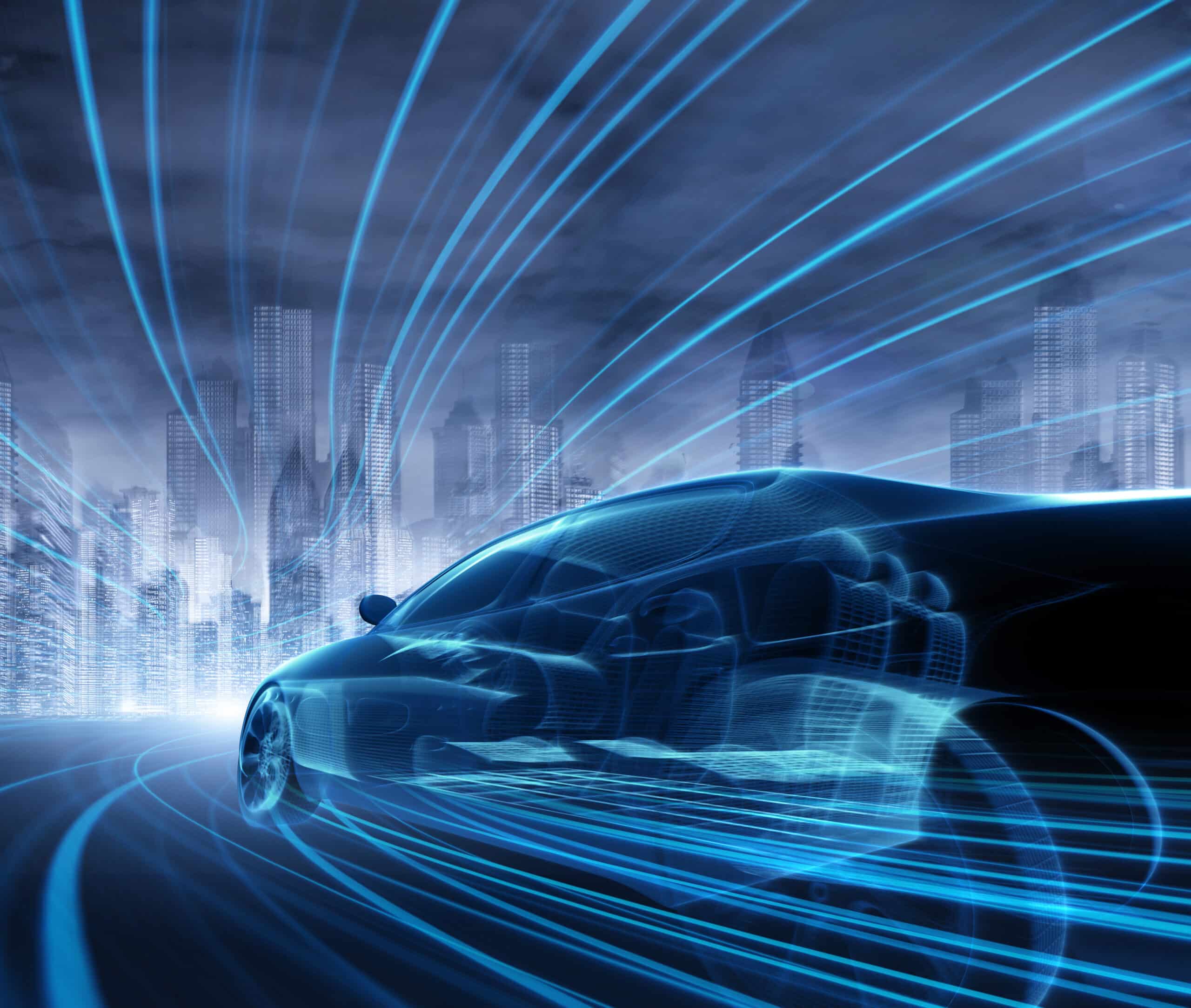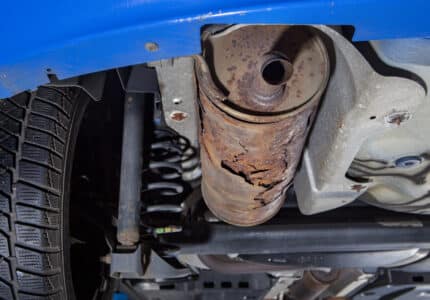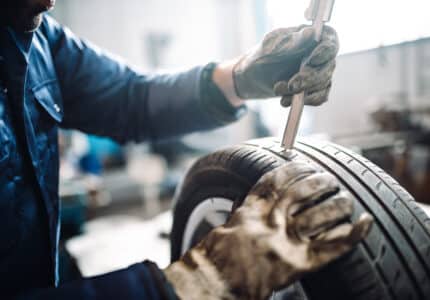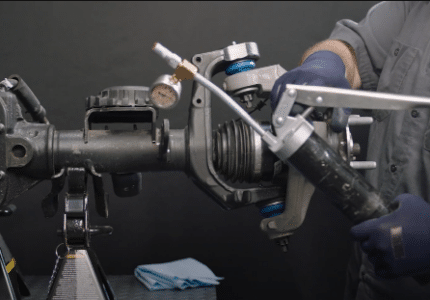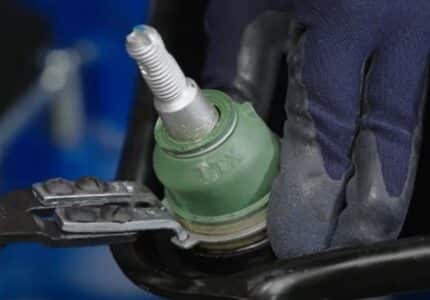AUTOMOTIVE TECHNOLOGIES: PAST, PRESENT, FUTURE & FAILURES
These are exciting times. Electric vehicles are the new normal, and advanced technologies, like driver-assistance systems and autonomous vehicles, are developing before our eyes. Along with these innovations come unique challenges for automotive steering and suspension systems. But how did we get here? Watch the on-demand webinar for insights into:
- Past technologies and how we got to where we are
- Current technologies and what’s fading away
- Future technologies and concepts vs reality
- Plus, honorable failures over the years
From the Past to the Present
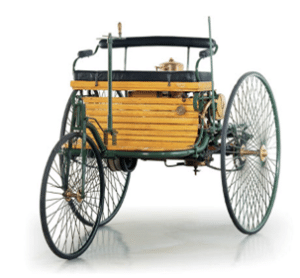 Taking a look back at how we got to where we are, the first officially recognized car was patented in 1886 by Carl Benz as the “vehicle powered by a gas engine” or “Benz Patent-Motorwagen.” It was a 954cc single-cylinder four-stroke engine on three wheels, capable of speeds around 10 mph. Only 25 were ever built. As the turn of the century approached, “horseless carriages” began to pop up everywhere and were starting to take on the name “automobile.” Their designers repurposed many of the technologies available on high-end horse carriages, including leaf spring suspensions and connection rod steering.
Taking a look back at how we got to where we are, the first officially recognized car was patented in 1886 by Carl Benz as the “vehicle powered by a gas engine” or “Benz Patent-Motorwagen.” It was a 954cc single-cylinder four-stroke engine on three wheels, capable of speeds around 10 mph. Only 25 were ever built. As the turn of the century approached, “horseless carriages” began to pop up everywhere and were starting to take on the name “automobile.” Their designers repurposed many of the technologies available on high-end horse carriages, including leaf spring suspensions and connection rod steering.
 Along with Henry Ford’s revolutionary assembly line manufacturing system introduced in 1913, automobiles started to look more like what we’ve become accustomed to, using mono-beam king-pin axles, a transverse leaf spring and draglink steering.
Along with Henry Ford’s revolutionary assembly line manufacturing system introduced in 1913, automobiles started to look more like what we’ve become accustomed to, using mono-beam king-pin axles, a transverse leaf spring and draglink steering.
SHOCK ABSORBERS
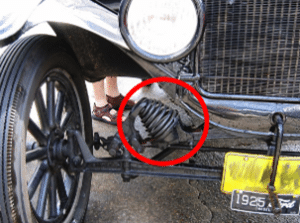 Some Ford Model Ts were outfitted with aftermarket suspension dampers, known as Hassler shocks. These were coil springs that worked to counteract the “bounciness” of the leaf springs.
Some Ford Model Ts were outfitted with aftermarket suspension dampers, known as Hassler shocks. These were coil springs that worked to counteract the “bounciness” of the leaf springs.

Early shock absorbers used friction discs made of wood, felt, leather and other materials that helped to bring spring oscillations under control. It didn’t take very long for these friction disc dampers to be replaced by much smoother operating hydraulic dampers.
INDEPENDENT SUSPENSIONS
There were (and still are) many variations of independent suspensions, from swing axles and sliding pillar suspensions on some early vehicles to the more traditional short-long arm (SLA) double wishbones and MacPherson struts in the 1940s. Improved shock absorber technology helped ensure constant contact between the wheels and the ground, drastically improving stability and making the ride much more comfortable.
BALL AND SOCKET JOINTS
Starting in the 1950s, ball and socket technology became the standard pivot point component in many suspension systems, and it is still found in all modern automobiles. Ball joints are used in multiple places, including the suspension and steering linkage, and in multiple configurations, including non-loaded (aka follower), compression-loaded and tension-loaded.
 When it comes to the bearings, ball joints have gone from having bare metal and spring-loaded plates to today’s polymer bearings and premium self-lubricating sintered metal bearings.
When it comes to the bearings, ball joints have gone from having bare metal and spring-loaded plates to today’s polymer bearings and premium self-lubricating sintered metal bearings.
STEERING LINKAGE SYSTEMS
From the original cross steer or drag link systems used on the first vehicles to the more complex parallelogram linkages, there have been many ways to steer a vehicle. Aside from larger pick-up trucks and SUVs, most vehicles have moved away from conventional steering linkages to rack and pinion.
POWER ASSISTED STEERING
With the introduction of power assisted steering on the 1951 Chrysler imperial, maneuvering heavy vehicles took much less effort. Originally, all power assisted steering was accomplished via a hydraulic system that used pressurized fluid. Although hydraulic systems are still in production, they are slowly being replaced by electric power assist.
Current Day Suspensions
 Most vehicles today take advantage of the simple, space-saving and economical design of a MacPherson strut system. Popular on unibody vehicles, this system allows for good performance and a fair amount of adjustability.
Most vehicles today take advantage of the simple, space-saving and economical design of a MacPherson strut system. Popular on unibody vehicles, this system allows for good performance and a fair amount of adjustability.

SLA or double wishbone systems are also used on many vehicle platforms, for a smoother driving experience. They maintain wheel alignment over bumpy roads, providing better overall performance versus a MacPherson strut system.
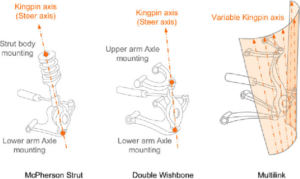 With modern drivers wanting both performance and comfort, multi-link suspensions have become increasingly popular. They create a virtual pivot point that provides a variable kingpin axis, which is highly effective at managing camber and keeping the wheel in full contact with the ground.
With modern drivers wanting both performance and comfort, multi-link suspensions have become increasingly popular. They create a virtual pivot point that provides a variable kingpin axis, which is highly effective at managing camber and keeping the wheel in full contact with the ground.
Future Concepts or Reality?
The future of automotive suspensions is ever changing, with new concepts and innovations being thought up daily. Although some may seem like science fiction, some are almost here and others are already here, including autonomous vehicles, which are ushering in a whole new perspective on how we “drive” and testing our trust in technology.
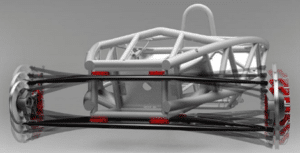 A British company is busy developing a suspension system called lightweight innovative flexible technology (LIFT). Based on an SLA suspension, LIFT is a flexible arm system that can potentially generate electricity and contribute some of the power required to drive an electric vehicle.
A British company is busy developing a suspension system called lightweight innovative flexible technology (LIFT). Based on an SLA suspension, LIFT is a flexible arm system that can potentially generate electricity and contribute some of the power required to drive an electric vehicle.
 Electric drive corner modules, or what some are calling e-Corners, are another innovation that may come to fruition sooner rather than later. The drive unit has been moved into the wheel, eliminating the need for a drive shaft on a driven wheel. This system opens up a host of possibilities, such as driving sideways into a parking spot, rather than parallel parking. Many companies have invested in this technology, with Hyundai Mobis being one of the front runners.
Electric drive corner modules, or what some are calling e-Corners, are another innovation that may come to fruition sooner rather than later. The drive unit has been moved into the wheel, eliminating the need for a drive shaft on a driven wheel. This system opens up a host of possibilities, such as driving sideways into a parking spot, rather than parallel parking. Many companies have invested in this technology, with Hyundai Mobis being one of the front runners.
Some automotive companies are also looking to harvest the kinetic energy available in the road-induced movement of a suspension system. Audi’s electromechanical rotary (eROT) damper system, for example, replaces hydraulic dampers to both smoothen out the overall ride and generate electricity for recharging the fuel cell, similar to regenerative braking.
 Steer by wire is an innovation that has recently become a reality, with Toyota planning on releasing the Lexus RZ450 in North America without a mechanical connection between the steering wheel and the front wheels. This system opens up a lot of possibilities for both steering wheel configuration and placement. Tesla has also just applied for a steer by wire system, featuring a proprietary redundancy system.
Steer by wire is an innovation that has recently become a reality, with Toyota planning on releasing the Lexus RZ450 in North America without a mechanical connection between the steering wheel and the front wheels. This system opens up a lot of possibilities for both steering wheel configuration and placement. Tesla has also just applied for a steer by wire system, featuring a proprietary redundancy system.
Honorable Failures
 An invention that was brought to market on more than one occasion, the 5th wheel parking system was patented in the 1930s with multiple attempts at success well into the 1970s.
An invention that was brought to market on more than one occasion, the 5th wheel parking system was patented in the 1930s with multiple attempts at success well into the 1970s.

Another innovative idea was having the front wheels toe inwards almost 90° when maneuvering a car. Although this may look like an ingenious invention, it never really took off and there isn’t much information available on it.
Summary
If you’re interested in learning more about how some automotive technologies have succeeded over the years, how some have failed and what the future holds, watch the webinar, Automotive Technologies: Past, Present, Future & Failures.
